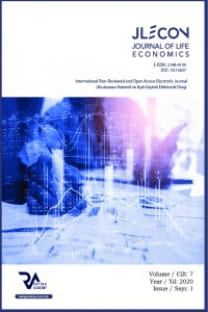Bitcoin kaotik analizi ve fiyat tahmin modeli önerisi
Kaos Teorisi, doğrusal olmayan dinamik sistemlerin davranışlarını tanımlar ve ekonomi alanında pek çok verinin modellenmesinde kullanılır. Kaos teori, sistemin doğrusal olmayan ve deterministik bir süreç olduğu varsayımlarına dayanır. Doğrusal modeller, ekonometrik sistemleri karmaşıklıklarını ortaya çıkarmakta yetersiz kalmaktadır. Bu çalışmanın amacı, Bitcoin günlük fiyatlarının zamana bağlı doğrusal olmayan dinamik bir sistem tarafından üretilip üretilmediğini araştırmak ve sistemin uzun vadede geleceğe yönelik tahmin yeteneğini araştırmak ve bir tahminleme modeli oluşturmaktır. Birçok ekonomik veri serisinin kaotik davranış gösterdiği bilinmektedir. Bu çalışmada, Bitcoin fiyatlarının kaotik yapısı incelenmiş ve regresyon yöntemi kullanılarak tahmin modeli kurulmuştur. Diğer bir ifadeyle amaç, Bitcoin fiyatlarının getirilerinin kaotik bir davranış gösterip göstermediğini ortaya koyarak elde edilen gömme (embedding) boyutuna bağlı olarak regresyon yöntemini kullanarak tahmin modeli oluşturmaktır. Çalışmada, 2021 Şubat – 2021 Kasım döneminde günlük kapanış fiyatı ( $ ) veri olarak kullanılmıştır. (URL-1,2021)
Anahtar Kelimeler:
Kaos Teorisi, Faz Uzayı, Zaman Serisi, Gömme (Embedding) Boyutu, Doğrusal Olmayan Kaotik Sistem, Bitcoin, Regresyon Modeli
Bitcoin chaotic analysis: A price forecasting model proposal
Chaos theory describes the behavior of nonlinear dynamic systems and has been used in solving a wide range of problems in economics. The theory of Chaos is based on the assumption that the underlying system is a nonlinear deterministic process. On the other hand, linear models, which are proven to be insufficient in revealing the complexities of economic systems, are not seen as an appropriate modelling approach for analyzing economic data which show chaotic behavior. The focus of this study is two-fold; the first objective is to investigate whether Bitcoin’s non-linear daily price change shows a chaotic behavior. The second objective is to investigate whether the system is suitable for a long-term forecast. The current research investigates both objectives by conducting a prediction model by using a regression model which depends on the embedding size. In order to capture the rich dynamic information hidden in the price changes of Bitcoin, we use the daily closing prices ($) of Bitcoin between the two periods February 2021 and November 2021. The data for such analysis was obtained from marketwach.com.
Keywords:
Chaos Theory, Phase Space, Time Series, Embedding Dimension, Nonlinear Chaotic System, Bitcoin, Regression Model,
___
- ALBOSTAN, A. ÖNSÖZ, B. (2015). Günlük Akarsu Akımlarının Kaotik Analizinde Dalgacık Yaklaşımının Uygulaması Journal of the Faculty of Engineering and Architecture of Gazi University. 30( 1), 39-48.
- BOEING,G. (2016). Visual Analysis of Nonlinear Dynamical Systems:Chaos, Fractals, Self-Similarity and the Limits of Prediction. Systems,4(4),37.
- CLARK, A. (2006) .Modelling the net flows of U.S. mutual funds with stochastic catastrophe theory .The European Physical Journal B.50, 659–669.
- GANGOPADHYAY, P., ELKANJ, N., RAHMAN, M. A. (2011). Application of Theories of Complexity and Chaos to Economic Misgovernance. Journal of Mathematics and Statistics.7(3):239 248.
- GRASSBERGER P AND PROCACCIA I. (1983). Dimension and entropies of strange attractors from a fluctuating dynamics approach Physica.D,13,34-54.
- ISERI, M., CAGLAR, H.,CAGLAR,N. ( 2008.) A model proposal for the chaotic structure of Istanbul stock exchange, Chaos, Solitons & Fractals, Elsevier. 36(5):1392-1398.
- NICHOLS, NANCY A. (1993). Efficient? Chaotic What’s the New Finance?. Harvard Business Review. 71(5):0017-8012.
- SAKIZ,B. & GENCER,A.H. (2017).Yapay Sinir Ağları ile Bitcoin Fiyatını Tahminleme. International Confrerence on Eurasian Economics.
- SLOAN, K.,(2011). Viewing Organizations Through the Lens of Chaos Theory: Thoughts on Applicability and Usefulness. European Journal of Social Sciences. 21(3).
- TAKENS F. (1981).Detecting strange attractors in turbulance. New-York: Springer-Verlag. pp .366-381.
- PETERS,E. (1991). Choas and order in the capital markets. New York: John Wiley&Sons Inc.
- Yayın Aralığı: Yılda 4 Sayı
- Başlangıç: 2014
- Yayıncı: Rating Academy
